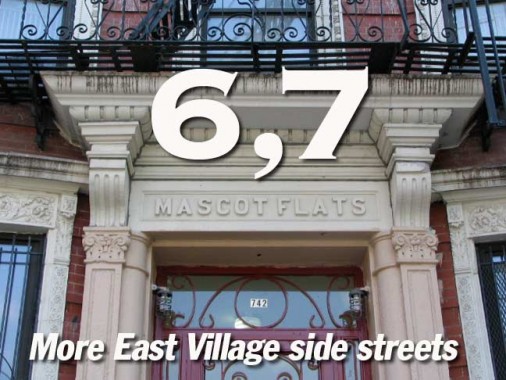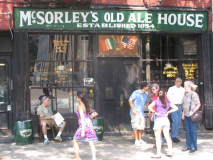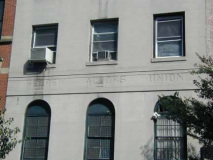4/12/08: a couple of weeks ago FNY walked East 3rd, 4th and 5th Streets in the East Village, and your webmaster had promised a look at East 6th and 7th Streets, which I had also photographed that day. Circumstances intervened, though, and I convened an emergency session of ForgottenFans to descend on the Cheyenne Diner on its final weekend (at least, its final weekend of business at 9th Avenue and 33rd Street) for one last Mohegan burger.
This week, though, we’ll resume the East Village swing (and 2nd Avenue will be following soon). Other urban explorers such as Caleb Smith and Satanslaundromat have walked every block in Manhattan, a record your webmaster has not approached and has no desire of matching, but a project to walk every block, say between 5th Avenue and the East River is a possibility.
I’m fascinated by places that were once poverty-stricken and dangerous but have been resuscitated. I’ve heard recently from people who lived in the East Village in the bad old days like photographer Ken Schles and musician Larry Kirwan who assure me that danger was your best friend there back in the 70s and 80s. Your webmaster feels just the slightest pang of guilt when traversing the East Village, Times Square, Morrisania, Fort Greene, places that were once much more dicey than now. Could I have felt free to walk where I wished with a camera then? Nowadays problems of a different sort occur: in the post 9/11/01 era I have more to fear from overzealous security agents than thieves and troublemakers.
Heading east on East 7th from Cooper Square, the first stop is McSorley’s Old Ale House, established (so they say) in 1854 making it the oldest NYC groggery still operating under its original moniker. Whether 1854 is the year it opened, though, has been called into question; while the venerable establishment itself claims 1854, as do most NYC guides, historian Richard McDermott, citing insurance and tax records, avers that 1862 was its first year in business:
The tax assesments records in the N.Y.C. Municpal Archives (31 Chambers Street) show that 15 East Seventh Street was a vacant lot through 1858. The William Perris Company insurance maps in the New York Historical Society and the Map Room in the New York Public Library (5th and 42nd) show an empty lot in 1859. The first mention of McSorley’s as a drinking establishment in any New York directory is 1862. [McDermott, Pace Press message board]
Your webmaster has only drank at McSorley’s once and, while I found it a satisfyingly atmospheric place to spend an afternoon, I was put off by the hostility I encountered when I initially forgot the McSorley’s rule: dark or light McSorley’s ale and no other brands. Cut me some slack already.
31 East 7th. The letters are faint now but they spell out some of the area’s Jewish legacy:
The Hebrew Actors’ Union (HAU), formed in 1899 as a craft union for actors in Yiddish theater in the United States (primarily in New York City), was the first actors’ union in the United States. Until it was decertified by the umbrella organization of theatrical unions in October 2005, it remained as one of the seven branches of the Associated Actors and Artistes of America (4As).It was founded by Jewish labor leader Joseph Barondess.
A 1925 article in The New York Times described the union as having, at that time, “over three hundred” members, and notes that it has, “not only placed all of its members in good positions, but [that] it has also granted many privileges to non-members…” It also notes that, “A great many members of the union are American-born and all of them are thoroughly Americanized.” The union represented “performers (except musicians) who are engaged in the field of Hebrew or Yiddish Language Theater”. [wikipedia]
Meanwhile, close by on 2nd Avenue and East 10th Street at the old 2nd Avenue Deli site, the superstars of Yiddish theatre have their names set in stone in the sidewalk. The names include Herman Yablokoff, Bella Meisel, Leon Liebgold, Lilly Lilyana, Sholom Secunda, who wrote, “Bei Mir Bist Du Schon” (parodied by radio host Jean Shepherd as “The Bear Missed the Train”) as well as Fyvush Finkel, who played folksy Douglas Wambaugh on the 1990s TV show Picket Fences, winning an Emmy Award, and later a teacher on Boston Public.
I am fascinated by NYC’s myriad war memorials — Cal Snyder’s Out of Fire and Valor lists many of them — but this one is in an unusual midblock location, 33 East 7th — delineating the soldiers from this one block of East 7th between Cooper Square and 2nd Avenue who fought in World War II.
101 East 7th: St. Stanislaus Roman Catholic Church. The parish has been in existence since 1872 and this church has been here since 1900; Polish President Lech Walesa visted in 1999 and 2001.
Jim Naureckas of NY Songlines: There used to be some tension between this Polish-oriented Roman Catholic church and Body Worship, across the street, because the church’s statue of Pope John Paul II had to look at some pretty risque window displays.
At 121 is St. Mary’s (American Carpatho-Russian) Orthodox Church. From the cleverly-named Slavs of New York site:
The building started out as part of the Hungarian Reformed Church, then the Carpatho-Rusyns moved in. The group is pretty evenly split between the Green Catholic and Orthodox Churches, and in the United States in the early 20th century it was not uncommon for entire parishes to go from one to the other. Like this one. The Carpatho-Rusyns here started out as Ressurection Greek Catholic Church, and then became the Eastern Orthodox Church of SS. Peter and Paul. They settled on the name St. Mary’s in the 1960s.
111 East 7th is one of the street’s many handsome apartment buildings. Note the openings to the inner courtyard and the Ionic columns (strictly speaking, column fronts) at the front entrance and windows on the 2nd and 3rd floors. It’s likely named for President William McKinley (1843-1901) and likely was built during, or just after, his tenure.
Note, also, that bars remain necessary on first floor windows on both this building and on St. Stanislaus Church.
Glass and mosaic detail depicting the Blessed Mother and Jesus. Note the footless angels in the mosaic: some artists show them this way because angels are sometimes referred to as never touching the ground.
Signage of different eras: Niagara, at Avenue A and East 7th, and Dora Park Apartments, 172-176 near Avenue B. Note the flower boxes placed above the door.
Look at all those details!
East 7th Street and Avenue B. LEFT: St. Brigid’s Church, a Roman Catholic church designed by one of the Northeast’s busiest ecclesiastical architects, Patrick Keely, beginning in 1848; the work was accomplished in large part by Irish who had fled the Great Irish Famine of 1845-1852. The Diocese of New York, citing unsafe conditions in the church, disbanded the parish in 2004 and the East Village has been involved in a battle to save the building that is as bitter, if not more so, than the one in Maspeth, Queens to save the equally venerable St. Saviour’s Episcopal Church. RIGHT: ad palimpsest: funeral parlor and catering hall.
Ancient bank, NE corner of Avenue C. Even Jim Naureckas doesn’t know what bank this was; he describes it as “building that looks like Cthulhu’s bank has housed artists for decades.”
Ah, Cthulhu, the gelatinous, octopus-headed dragon of H.P. Lovecraft’s fevered fiction; the Ghostly Gentleman was always peppering his stories with muti-tentacled, multi-eyed Things that were always being summoned by one incantation or other. But he also was quite the philosopher…
The most merciful thing in the world, I think, is the inability of the human mind to correlate all its contents. We live on a placid island of ignorance in the midst of black seas of infinity, and it was not meant that we should voyage far. The sciences, each straining in its own direction, have hitherto harmed us little; but some day the piecing together of dissociated knowledge will open up such terrifying vistas of reality, and of our frightful position therein, that we shall either go mad from the revelation or flee from the light into the peace and safety of a new dark age. (Lovecraft, in The Call of Cthulhu]
Some information about the bank has surfaced: it used to be the Public National Bank
I found a few NY Times articles on the Public National Bank: In 1920, the bank’s president was Edward S. Rothschild — he made the news when he received a record offer of $1750 a year to lease a building the bank owned at 537 5th Avenue between 44th and 45th. In February 1921 the bank was doing quite well and an embarking on expanding their location at Graham and Siegel in Williamsburg, to a newer bigger lot that they purchased just a block away on Graham. They also had a branch on Pitkin Avenue in Brooklyn, and Delancey at Ludlow in Manhattan. In July of 1921, a teller in their 23rd St. and Broadway branch in Manhattan Ave, succeeded in committing suicide in the bank’s basement by shooting himself in the head. The bank’s 7th and C branch was bought from the J.J. McComb Company in September 1922. A 1990 obit for a former VP and President of the bank, Benjamin Schoenfein, stated that the Public National Bank was acquired by the Bankers Trust Company (now Deutsche Bank) in 1955. I couldn’t find any articles about the E. Village branch closing, but perhaps it happened after Banker’s Trust took over (I’m just speculating). [Forgotten Fan Diane Ingino]
Looking at the map, I’m mystified about why East 5th and 6th have higher house numbers than 2nd, 3rd, and especially East 4th, which runs continuously east from Broadway; the other streets begin at the Bowery. North of that, East 9th outpaces 7th, 8th and 10th, but is equaled by 11th through 14th. It’s strange because while both East 9th and 10th begain at Broadway, East 9th’s numbering goes up more slowly than 10th’s. Anyone have any ideas?
Turning west at East 6th…
Mascot Flats, 742 East 6th, sounds like the title of a Steinbeck book. This was the first NYC building restored by Habitat for Humanity, in 1985, and thus The Man From Plains has been here. The building, previously an abandoned tenement, was restored by East Village locals under the HFH umbrella.
East 6th between B and C (“naturally,” the 6BC Garden) The East Village’s community gardens look like nothing special in winter, but wash the streets in green in summer. To think Rudy G. tried to get rid of the gardens…
Heading west on East 6th I was fascinated by the multitudes of different styles on building entrances; 540’s was probably added later, since it seems Moderne next to the Beaux Arts remainder; check the high arch on the front of 538.
Stumbling into Creative Little Garden at 530 E. 6th I was rewarded by some terra cotta art and a fancy lamp.
Building fronts between Avenues A and B on East 6th. As different as all these are– all of them have the same style building number (closeup at left).
Anyone know how this came about? My guess would be that the block association wanted to impose some sort of uniform style, and this is what they came up with.
505 East 6th –Eastern Bloc, the exterior a natural for glass block fans like your webmaster. The glass blocks are about all I’d like there, though, I suspect. Replaced Wonder Bar.
I was attracted by the bare storefront and red paint job at 507 East 6th. Speaking as someone who has never seen his abdominal muscles (I’m not sure I have them) I have always found bodybuilding competitions exercises in grotesquery. Now, don’t beat me up over that.
The East Village is like Top 40 WABC Musicradio in the 60s (or the WMCA Good Guys if you prefer) –one great song after another, and one great building after another. Two more amazing examples at 421 and 440 between Avenue A and 1st Avenue.
421 was a Con Edison substation built in 1920-21 that converted direct current to alternating. It is at present (2008) the studio of modern artist/sculptor Walter De Maria. His most famous installation is…
The Lightning Field (1977) is permanently installed in the desert at Quemado, New Mexico, and was commissioned by the Dia Art Foundation, who run the site and provide accommodation for visitors. The work consists of hundreds of stainless steel rods projecting from the ground to a uniform height of around six metres (20 feet). Rows of 20 rods extend for one mile, while rows of 16 extend for a kilometre, making a square grid of standard and metric proportions. The work is designed to attract spectacular lightning strikes. [Channel 4]
Between Cooper Square and 2nd Avenue. Obviously, I do not read Hebrew characters, so I cannot translate the signs on the building, which I take to be a synagogue. Some medieval styling at Villa East, 236 East 6th.
The building with Hebrew lettering that you showed towards the bottom of the East 6th and 7th page is indeed a synagogue (that’s what the lettering at the top of the building says). The name of the congregation, Anshe (“people of”) Meseritz, is right above the door. The synagogue is still in active use.
[Meseritz is a town in the Ukraine, from which I guess most of the original membership hailed. It was pretty common in those days for immigrant Jews from the same townor area (“landsleit,” as they’re called in Yiddish) to form their own congregation, charitable society, etc.] [Forgotten Fan Alex Heppenheimer]
The Ukrainian Museum, 222-224 East Sixth, showcases Ukrainian fine art, costume and music. Prominent artists of Ukrainian extraction exhibit here. An upcoming exhibit (beginning April 20, 2008) concerns maps of the Ukraine from 1550-1779.
Across the street is St. George’s Ukrainian Catholic School, and a block away on East 7th, across from McSorley’s, is the St. George Church, built from 1976-78 though it looks much older than that.
Walking around the corner to Taras Shevchenko Place and East 6th Street, we see three wildly divergent eras in NYC architecture: from right, the Metropolitan Bank (1867), Cooper Union (1857) and then, the undulating, glass-clad, amoeba-shaped Astor Place Apartments, called by its creator Charles Gwathmey as “Sculpture For Living” and by local detractors as “The Green Monster.” (2004).
This view is already no longer available, as Cooper is building its new Academic Building here.



